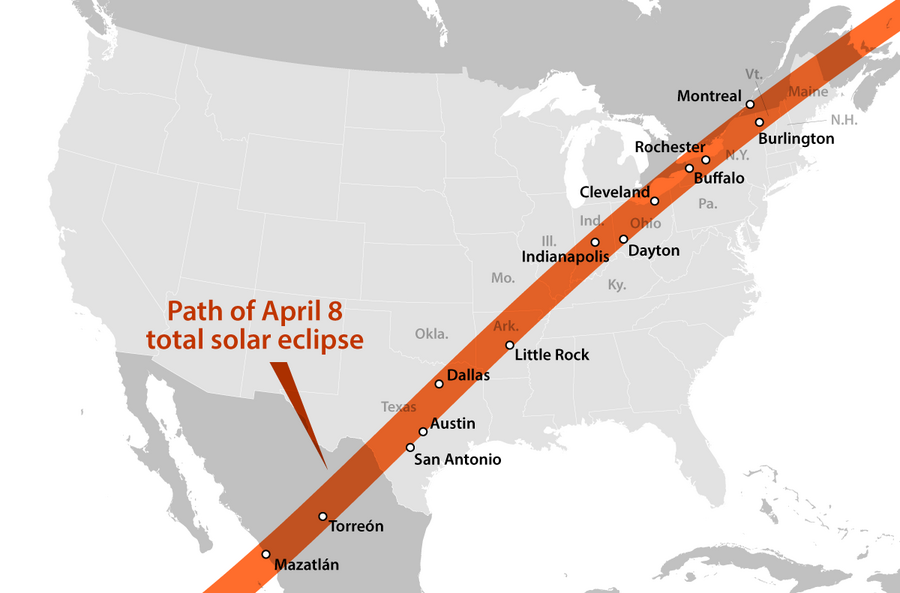On April 8, for about four minutes, many Americans will have the rare chance to witness a total solar eclipse. The last time that happened in North America was 2017 – and the next time won’t be until 2044. The eclipse, which occurs when the moon moves in front of the sun, will pass through a more densely populated path than in 2017, letting more people watch the darkened skies from their own homes.
When the sun is completely covered in the path of totality, viewers can remove their glasses for a few minutes and look directly at the sky. During this time, the temperature will drop, and birds will go silent. Depending on their location, some viewers may be able to see some particularly bright stars, or a 360-degree sunset.
Why We Wrote This
The total solar eclipse over North America next week offers a viewing opportunity that won’t be repeated until 2044. Eclipses not only are wonders, but also can play a role in helping us understand the cosmos.
Eclipses are a unique time for scientists to gather data. It allows them to observe the sun’s lower atmosphere, which is only visible during a solar eclipse, and to study “space weather,” which can sometimes cause electrical blackouts on earth.
“Not everyone cares about this, not everyone’s gonna stop what they’re doing, but I believe the majority of the people will,” says Jean Stehle, a school librarian. “And I think it really speaks to the power of wonder and the natural world.”
On April 8, for about four minutes, many Americans will have the rare chance to witness a total solar eclipse. The last time that happened in North America was 2017 – and the next time won’t be until 2044. The eclipse, which occurs when the moon moves in front of the sun, will pass through a more densely populated path than in 2017, letting more people watch the darkened skies from their own homes. Eclipse watchers are also expected to travel to localities along the path.
How can I watch the eclipse?
The stage in the eclipse when the moon entirely covers the sun, called totality, will last about four minutes. The path of totality, which starts on Mexico’s Pacific coast, will cross into Texas, slant across the Midwest, and end in Maine. All in all, 15 states will be in that narrow pathway, including cities like Cleveland and Indianapolis. Totality occurs at different times in different locations. In Dallas, it will start at 1:40 p.m. local time. If you’re in Burlington, Vermont, it will be 3:26 p.m.
Why We Wrote This
The total solar eclipse over North America next week offers a viewing opportunity that won’t be repeated until 2044. Eclipses not only are wonders, but also can play a role in helping us understand the cosmos.
The partial eclipse, in which the moon covers only part of the sun, will last a little longer than an hour. In this zone, NASA warns that viewers will need to wear protective eclipse glasses if they want to look at the sun directly, or use a special filter to observe it via camera lens, binoculars, or a telescope. The American Astronomical Society has a list of which glasses and filters are safe to use.

When the sun is completely covered in the path of totality, viewers can remove their glasses for a few minutes and look directly at the sky. During this time, the temperature will drop, and birds will go silent. Depending on their location, some viewers may be able to see some particularly bright stars, or a 360-degree sunset.
What if I don’t live in the totality line?
Unlike in 2017, the solar eclipse will be at least partially visible in 48 U.S. states. Even for communities far from totality, there will be interesting changes to watch. Astronomers say that leading up to the eclipse, some colors in natural light may appear saturated, and shadows may start to look fuzzy. As the moon glides across the sun, viewers can use a colander, a straw hat, or even a Ritz cracker to project shadow images of the sun’s crescent shape. They should also be on the lookout for unusual animal behaviors. Right before the eclipse, wildlife like birds and insects might act as if it were nighttime.
What are some scientific experiments to follow during the eclipse?
Eclipses are a unique time for scientists to gather data that’s usually unavailable. For example, an eclipse allows them to observe the sun’s lower atmosphere, which is only visible during a solar eclipse because the sun’s rays don’t block it out. An eclipse also helps them study “space weather,’’ which can sometimes cause electrical blackouts on earth.
Researchers will also be studying animal reactions at zoos. During the 2017 eclipse, some scientists noticed behaviors that ranged from galloping giraffes to sleeping gorillas. This time around, researchers will have teams stationed at zoos, and they’ve also called on citizen scientists, or hobbyists and everyday individuals with a love for science, to send in their wildlife observations from around the country.
How are communities engaging with the eclipse?
Museums and community centers across the country are hosting special events on April 8. The Smithsonian’s National Air and Space Museum will set up telescopes on the National Mall in Washington. The central library in Austin, Texas, will host a public viewing with activities for kids. And Aroostook County in Maine is designating some green spaces as “star parks” and equipping them with restrooms and parking.
“One of the reasons why this is a bigger deal than 2017 is that 36 million people naturally just live in that path of totality,” says John Jerit, CEO of American Paper Optics, a company that designs and makes eclipse glasses.
To make safe viewing more accessible, American Paper Optics has created almost 5 million eclipse glasses for donation to 10,000 U.S. libraries, using funding from the Gordon and Betty Moore Foundation and Space Science Institute.
As libraries hand out the free glasses, many of them are also educating recipients about the eclipse. Jean Stehle, a librarian at Newton Middle School in Massachusetts, recently helped students act out the role of sun, moon, and Earth in an eclipse simulation. The students asked questions about how their pets would react, and excitedly pointed out their location on a map of the eclipse’s path.
“Not everyone cares about this, not everyone’s gonna stop what they’re doing, but I believe the majority of the people will,” says Ms. Stehle. “And I think it really speaks to the power of wonder and the natural world.”
Editor’s note: This story has been updated to clarify the funding source for the eclipse glasses donated to U.S. libraries.
>>> Read full article>>>
Copyright for syndicated content belongs to the linked Source : The Christian Science Monitor – https://www.csmonitor.com/USA/2024/0402/A-solar-eclipse-is-coming-April-8.-Here-s-what-you-need-to-know?icid=rss































